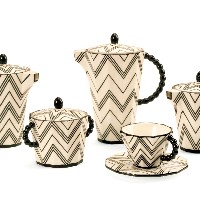Breadcrumbs navigation
What is Czech design?
Design isn’t exactly the first thing that comes to mind when people think about the Czech Republic. But in this small, creative nation there is a rich design scene that attracts more and more international attention every year.
What:
Glass and porcelain are the dominant materials. They are used to create design objects like vases and decorative items, as well as lights and lamps. Although furniture isn’t as well represented, the early decades of the 20th century saw the birth of some iconic pieces, mainly in wood. Wood toys and toys in general have a long and varied tradition here. Jewellery is also very strong and Czech fashion has recently come into its own, as well.
How:
Czech design is marked by precision, craftsmanship and a Czech twist (a sense of humour and a sometimes quirky take). It is often on the border of art and craft. It is influenced by cubism, functionalism and history. The younger, well-travelled generation is blending that history with their international experiences.
Who & When:
Art Nouveau: Europe at the end of the 19th century was dominated by Art Nouveau. The Czech, Paris-based artist Alfons (Alphonse) Mucha was among its key figures, gaining renown especially for his posters commissioned by actress Sarah Bernhardt. His jewellery and textile designs were created for use in his paintings, but their inimitable elegance makes them popular to this day.
Cubism: Between 1911 and 1914, a group of Czech Cubist architects created ceramics, along with lights and furniture, in the Cubist style. A number of their designs are considered iconic today.
Interwar modernism: Following the First World War in 1918, the newly independent first Czechoslovak Republic experienced a remarkable period of affluence and creativity. In the interwar period, Czechoslovakia – as the new country was most commonly called – experienced a golden age of design, influenced by Bauhaus functionalism and Art Deco. The design of the era had a distinctive modern sensibility characterized by clean lines, simplicity, the use of local materials, and excellent craftsmanship, which along with its timeless appeal ensured superb product longevity.
The postwar period: Even the post-war period had its bright moments. Bruselský styl, “the Brussels Style“, was one; its name is derived from the phenomenal success of the Czechoslovak pavilion at the 1958 World Expo in Brussels, where it won the gold medal. The style was characterized by rounded curves, a bright, cheery palette, and the use of new materials such as laminate, aluminium, formica and plywood. Its influence lasted well into the 1970s.
Czech design legends: Pavel Janák, Josef Gočár, Vlastislav Hofman, Jindřich Halabala, Ladislav Sutnar, František Vízner, Jaroslav Ježek, Bořek Šípek, Jiří Pelcl
Some of today’s leading Czech designers and studios: Maxim Velčovský, Lucie Koldová, Dechem, Qubus, Rony Plesl, Olgoj Chorchoj, deFORM, Jan Plecháč & Henry Wielgus
